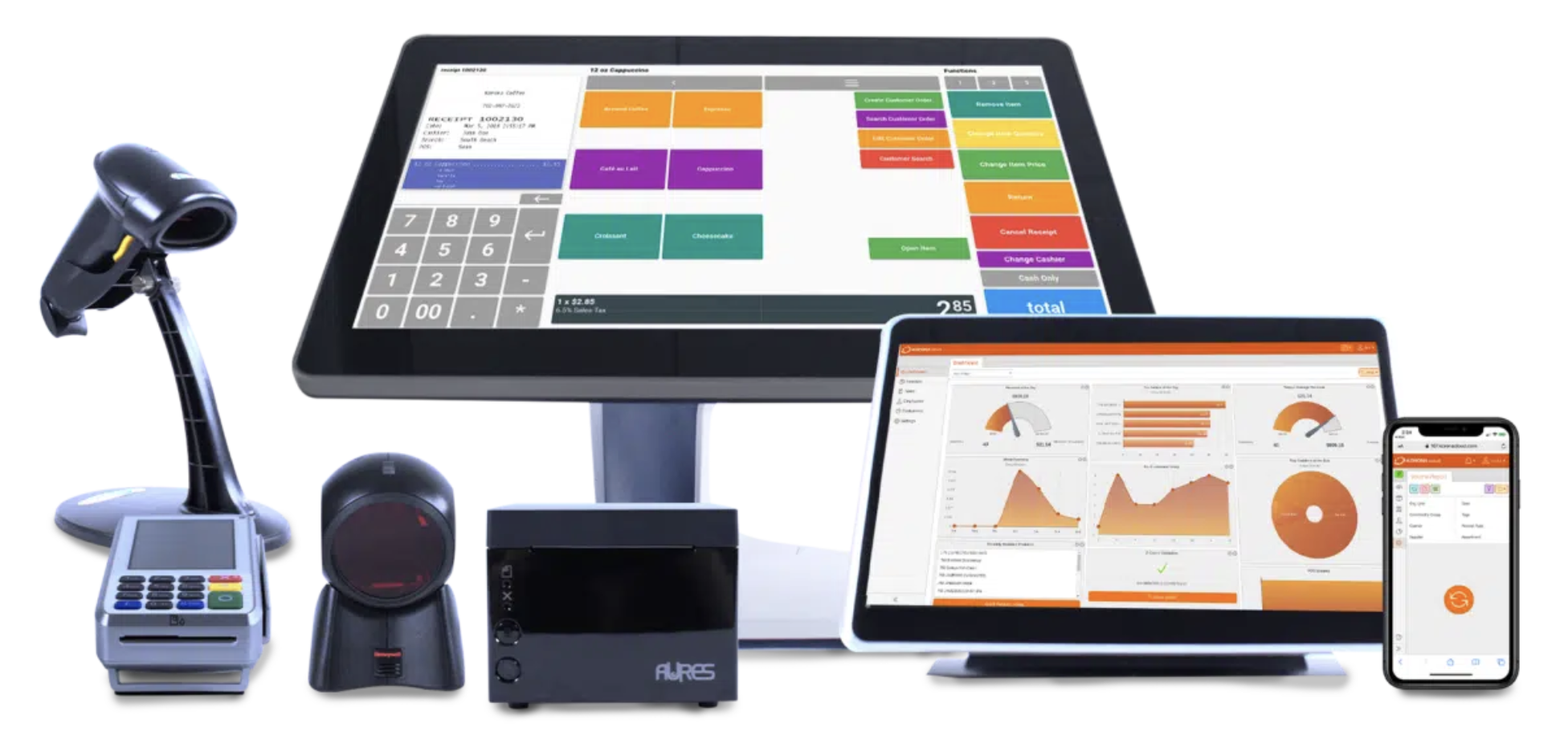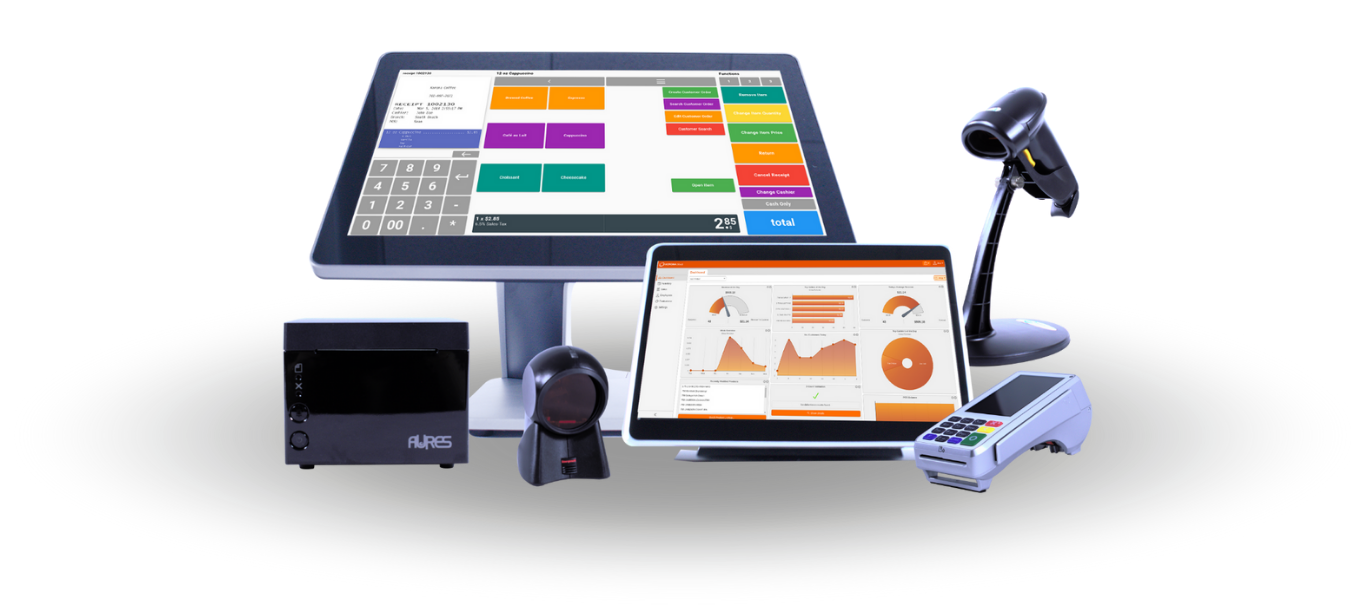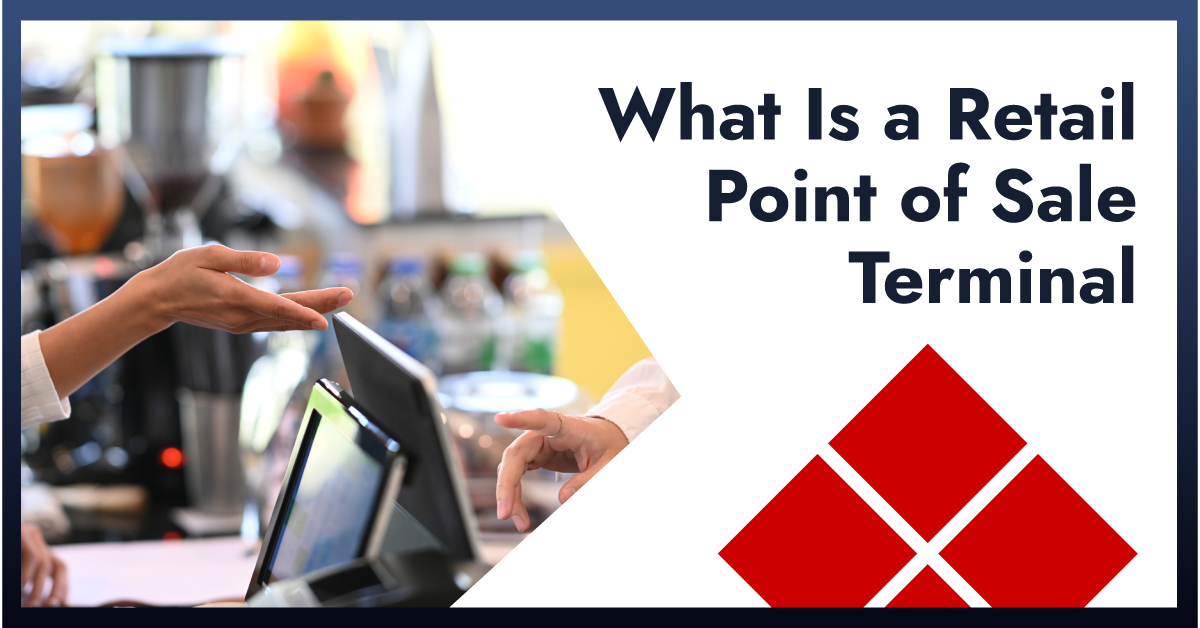Selecting the right point of sale (POS) system is crucial for any retail business. The POS terminal is the central hub for processing transactions, managing inventory, analyzing sales data, and optimizing customer experiences.
This comprehensive guide will explore the key components of a retail point of sale, the different types available, and some key factors to consider when choosing a POS terminal. Whether you run a single small shop or a chain of stores, this post covers everything you need to know about POS systems to make an informed decision for your business.
We examine the evolution of POS terminals from simple cash registers to today’s sophisticated omnichannel solutions and how the optimal setup can streamline your retail workflows, increase efficiency, and enable future growth.
What Is a Retail Point of Sale Terminal?

A POS terminal is a combination of software and hardware devices used to process sales transactions. It’s the culmination of the in-store shopping experience – the point where a customer pays the merchant in exchange for goods or services.
These electronic devices enable cashiers and staff to ring up customer purchases efficiently, process payments, look up inventory, access customer data, and perform various other retail functions.
Historically, this process began with simple cash registers that recorded sales, but with technological advancements, modern POS systems have become multifaceted, incorporating various functionalities from sales processing to inventory management.
Here is a brief timeline of the key developments in the history of POS terminals:
1879: James Ritty invents the first mechanical cash register.
1906: Charles F. Kettering creates an electric motor for the cash register.
1973: IBM introduced the first electronic cash register (ECR).
1986: Introduction of the first touchscreen POS system.
1990s: POS terminals began to incorporate barcode scanners and credit card processing.
2000s: POS terminals become more sophisticated and offer features such as inventory management, CRM, and loyalty programs.
2010s: POS terminals become mobile and cloud-based, making them more accessible and affordable for small businesses.
2020s: POS terminals are increasingly integrated with artificial intelligence (AI) and machine learning (ML) to help businesses automate tasks and improve customer service.
Components of a POS Terminal
A POS terminal is a symphony of hardware and software working in tandem.
Hardware components of a retail point of sale terminal
Cash drawer: This is a secure container where cash, coins, checks, and other paper transactions are stored during business hours. It is typically integrated with the POS system, opening automatically when a cash transaction is processed to allow for safe storage and easy change-making. The cash drawer is often lockable and helps in managing cash flow efficiently.
Receipt printer: A receipt printer is used to print out physical copies of the transaction receipts for customers. These printers are fast, efficient, and designed to handle a high volume of transactions. They can print itemized details of a purchase, including prices, taxes, and totals, and sometimes include the ability to print company logos or promotional messages.
Barcode scanner: This device reads the barcodes on products, streamlining the checkout process by quickly adding items to the transaction list without manual input. Barcode scanners can be handheld or stationary, using laser or imaging technologies to read the barcodes.
See also: Barcodes and QR Codes: Why Every Retail Business Needs Both
Customer-facing display: This is a screen facing the customer that shows transaction details, including purchased items and their prices, the total amount due, and any relevant messages (like loyalty points earned). It increases transparency and trust by allowing customers to see transaction details in real-time.
Tablets: In modern POS systems, tablets (like iPads or Android tablets) are often used as versatile, portable POS terminals. They can run POS software for mobile checkout experiences, inventory management, and customer engagement. Tablets can also integrate wirelessly with other POS hardware components, offering flexibility in how and where transactions are processed.
Card reader: A card reader in a retail point of sale system is crucial for processing electronic payments. It is designed to read the information stored on a customer’s debit or credit card. There are three types of card readers: magnetic stripe readers, chip readers (EMV readers), and contactless readers (NFC technology).
Software components of a retail point of sale terminal
Here’s a detailed look at each of these software components:
Payment processing: This software component is crucial for handling all aspects of payment transactions. It includes authorizing credit and debit card transactions, processing mobile payments, and ensuring secure data transmission. Payment processing software communicates with banks and credit card companies to verify the customer’s ability to pay and to finalize the transaction.
Read also: Retail Payment Processing: Ultimate Guide To Retailers
Inventory management: This feature helps retailers track and manage their stock levels in real-time. It records sales and adjusts inventory levels accordingly, provides alerts for low-stock items, and can automate reordering processes. Effective inventory management software helps reduce overstock and stockouts, thus optimizing inventory levels.
Integration with other retail management systems: POS systems often need to integrate with other retail and business management systems, such as accounting software, eCommerce platforms, and supply chain management tools. This integration ensures seamless data flow across systems, improving efficiency and accuracy in various realms, such as financial reporting, online sales, and inventory management.
You might also want to read: eCommerce Merchandising: 6 Essential Practices For Retailers
Reporting and analytics: Reporting and analytics tools within a POS system provide valuable insights into business performance. This component can generate reports on sales, customer behavior, inventory levels, staff performance, and more. These insights help make informed business decisions, identify trends, and understand customer preferences.
Customer management: This aspect of POS software focuses on managing customer relationships. It includes maintaining customer profiles, tracking purchase history, managing loyalty programs, and creating targeted marketing campaigns. By understanding customer preferences and shopping habits, businesses can personalize their services and offers, enhancing customer engagement and retention.
Staff management: Staff management tools in POS software help schedule, track, and manage employee hours and performance. This component typically includes time clock functionality, performance tracking, and even access control, where employees have different levels of access to the POS system based on their roles.
Omnichannel selling: Omnichannel selling features to ensure that the POS system integrates with various sales channels like online stores, mobile apps, and physical storefronts. This uniformity allows for a consistent customer experience, centralized inventory management, and improved sales tracking across all channels.
Types of POS Terminals
Legacy POS
Also known as traditional POS systems, these are the oldest type of POS systems. They typically involve a fixed terminal with hardware such as a computer, cash drawer, receipt printer, and barcode scanner. Legacy POS systems often run on closed networks and require on-site servers for data storage. While they can be less flexible and more costly to update, they are still used by many retailers.
Mobile POS (mPOS)
Mobile POS systems are portable and can be operated through smartphones or tablets. They are equipped with software that allows for payment processing and sales management. mPOS is ideal for small businesses, pop-up stores, or any retail setting where mobility is needed. They often use cloud-based software and accept various payment types, including credit cards, NFC (contactless) payments, and QR codes.
Cloud-based POS
These systems store data on remote servers and can be accessed over the Internet. Cloud-based POS systems are scalable, allowing businesses to add more terminals easily. They offer real-time data synchronization, which benefits businesses with multiple locations. These systems often have lower upfront costs than legacy systems and provide easier integration with other cloud-based applications.
Self-checkout POS
These are automated systems that allow customers to scan, bag, and pay for their items without cashier assistance. Common in grocery stores and large retail chains, self-checkout POS systems aim to reduce wait times and improve customer experience. They typically include a touchscreen, barcode scanner, payment terminal, and sometimes a weighing scale for items sold by weight.
Kiosk POS
Kiosk POS systems are standalone terminals designed for specific functions such as ticket sales, food ordering, or informational services. They are often found in malls, airports, and quick-service restaurants. These user-friendly systems can be customized to fit a business’s branding and specific needs.
Modular POS
Modular POS systems offer a mix of the features of legacy and modern cloud-based systems. They are adaptable and can be customized with various modules depending on the business’s needs. This could include different types of payment processing, inventory management, customer loyalty programs, and more. Modular systems allow upgrading or adding components as the business grows or changes.
Choosing The Right POS Terminal for Your Business
Choosing the right POS terminal for your retail business is a critical decision that can significantly impact your operations and customer experience. Here are some key considerations to help you select the most suitable POS system:
Understand your business needs
Assess the specific needs of your business. Consider factors like the size of your business, the volume of transactions, inventory complexity, and the types of products or services you offer. Also, think about your future growth plans and how the POS system can scale with your business.
Type of retail environment
Different retail environments may require different types of POS systems. For example, a mobile POS might be more suitable for pop-up shops or outdoor markets, while a more robust, legacy POS system might be better for a large, high-volume retail store.
Ease of use
The POS system should be user-friendly for both your staff and customers. It should have an intuitive interface and straightforward functionality to minimize training time and errors during transactions.
Payment processing capabilities
Ensure the POS system can handle various payment types, including credit/debit cards, mobile payments, and contactless payments. It’s also important to consider the transaction fees associated with different payment methods. You also need to choose a processing-agnostic solution (A POS that integrates with any payment processor). This will enable you to negotiate rates that suit your business.
Integration with other systems
The POS system should easily integrate with other software you use, such as accounting software, inventory management systems, customer relationship management (CRM) systems, and eCommerce platforms. Integrations help streamline your operations and provide a unified view of your business.
Inventory management
If managing inventory is a significant part of your business, look for a POS system with robust inventory management features like real-time tracking, automated reordering, and detailed reports.
Customer management and loyalty programs
Consider POS systems that offer customer management features, such as tracking purchase history and preferences. Integration with loyalty programs can also enhance customer retention and increase sales.
Reporting and analytics
Choose a POS system that provides comprehensive reporting and analytics tools. Analyzing sales data, customer behavior, and inventory trends will offer valuable insights for business decisions.
Hardware requirements
Assess the hardware requirements of the POS system. Consider the space available in your store and whether you prefer stationary terminals or mobile devices. Also, consider the durability and longevity of the hardware.
Security and compliance
Security is paramount in POS systems to protect sensitive customer data. Ensure the system complies with industry standards like PCI DSS (Payment Card Industry Data Security Standard). Regular updates and security features like encryption are essential.
Cost and budget
Evaluate the cost of the POS system, including upfront costs, monthly fees, and transaction fees. Ensure the costs align with your budget and offer good value for the features and services provided.
Customer support and training
Good customer support and training resources are essential, especially during the initial setup and for ongoing assistance. Check if the vendor offers reliable customer support and training materials.
Read also: Understanding the Importance of POS Support and POS Customer Service
Scalability and flexibility
The POS system should be scalable to accommodate your business’s growth. It should offer flexibility in adding new features, terminals, or integrations as your business needs evolve.
Choosing COMBASE USA POS Terminals

When it comes to selecting the best retail point-of-sale (POS) system, COMBASE USA’s KORONA POS terminals stand out as the top choice for retailers. COMBASE USA is the company behind the innovative development of the KORONA POS system. The hardware of KORONA POS includes sleek, durable terminals with large touchscreen displays, built-in printers, and options for additional peripherals like barcode scanners and customer-facing displays.
On the software side, KORONA POS offers robust features like sales tracking, inventory management, customer loyalty programs, and seamless integration with accounting software. With its combination of cutting-edge hardware and feature-rich software, the KORONA POS system from COMBASE USA delivers the performance and reliability retailers need in a modern POS solution. Choosing COMBASE USA for retail POS terminals ensures stores get a future-proof system with the flexibility to grow. Click here to get started with KORONA POS.

